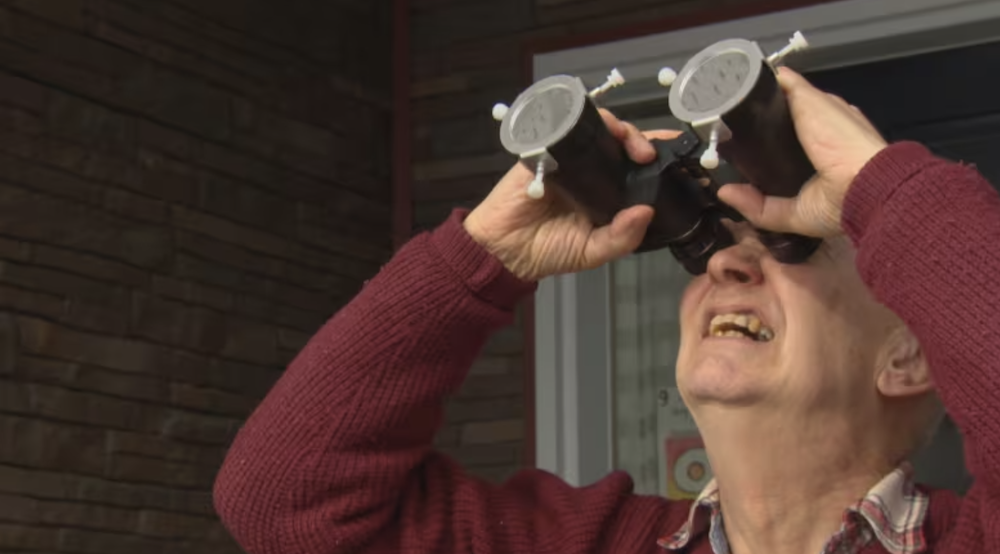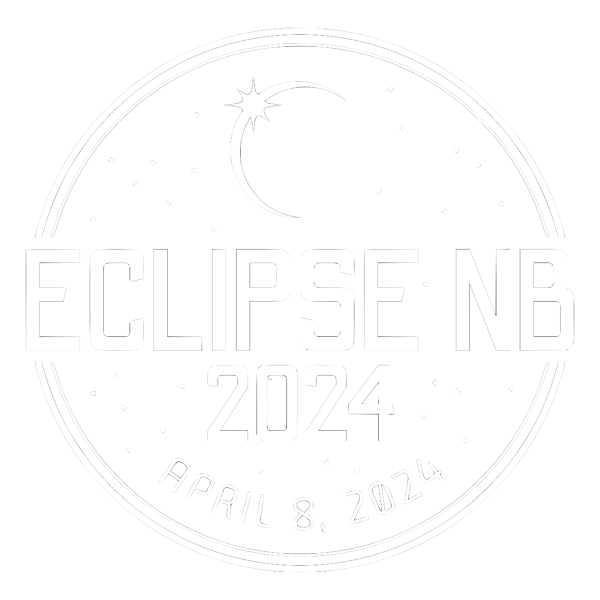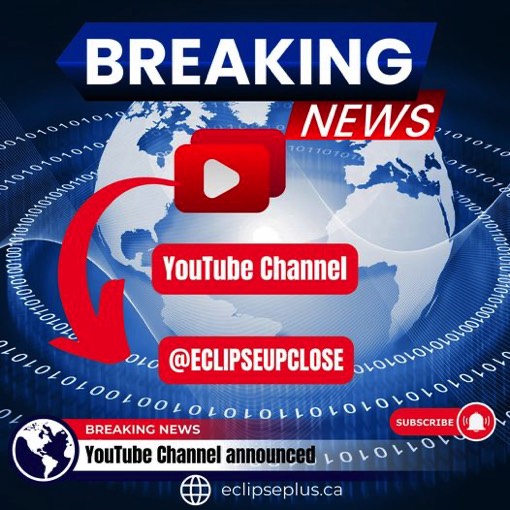What are the chances of clear skies for the total solar eclipse?
April isn't the best month for clear skies across Canada, but that doesn't mean we'll miss out
Nicole Mortillaro · CBC News
Mar 25, 2024 — By now you've heard the buzz about the total solar eclipse happening on April 8. Though people are rushing to purchase eclipse glasses to witness the spectacle, one of the biggest questions remains: Will we have clear skies?
Unfortunately, April skies in Canada — and particularly those areas along the path of totality — tend to experience frequent cloud cover. But that doesn't mean one should lose hope.
"April is not the best month for observing astronomical phenomena in Canada," said David Phillips, senior climatologist with Environment and Climate Change Canada. "Further, the jet stream is changing positions from winter to summer patterns. As a result, it is a time for more cloud cover and travelling weather systems passing through."
The path of totality — where observers will see the moon entirely cover the sun, at about 3 p.m. local time — will arc from southwestern Ontario, and along the St. Lawrence River toward Fredericton and St. John's.
Phillips provided CBC News with 30-year averages for cloud cover for southeastern Canada in April at that time of day.
Click here to read article (Our Solar Balloon Project is mentioned at the bottom of the article)
YouTube link to LIVE-STREAMED video feed from the Eclipse Balloon Project announced
If you aren’t in the path of totality, or if it happens to be cloudy where you are, don’t miss out... You can watch the eclipse in real time by following the Eclipse Plus YouTube channel: @EclipseUpClose
At approximately 3:30 pm ADT on April 8th, the Solar Eclipse Balloon Project will launch a balloon capable of ascending up to 30 Km into the stratosphere, well above the clouds, to live-stream dramatic video and images of the Sun, Moon and horizon back to the ground and to the Internet via YouTube.
Launched from Florenceville-Bristol, New Brunswick, images will be live-streamed to the World Wide Web and fed to a large screen at the launch site ground station as well as to seven viewing centres — two in Florenceville-Bristol, one in each of Woodstock, Hartland, Perth-Andover, Grand Falls and Plaster Rock, New Brunswick.
The payload has 6 cameras on board, one of which will be taking continuous video and one of which will be dynamically aimed at the Sun. The YouTube feed will have images only and will not have audio or narration
As the only citizen-led project of its kind outside of NASA, the Solar Eclipse Balloon Project could not have taken place without a huge team of volunteers, as well as generous sponsors, partners and donors.
New Brunswick volunteers build flying telescope to see total eclipse above the clouds

CTV Atlantic | News
By Michael MacDonald | The Canadian Press Staff
March 10, 2024 —Early next month, millions of Canadians will gaze skyward to witness a total solar eclipse. But some stand to be disappointed as clouds get in the way.
David Hunter plans to have an unobstructed view, and he's inviting others to join him. The retired medical physicist in western New Brunswick has led a group of volunteers to build a sun-tracking telescope that will be hoisted aloft by a weather balloon on the afternoon of April 8.
"The primary goal is to get over any existing cloud cover," Hunter said in an interview, adding that the helium-filled balloon could rise as high as 30 kilometres above the Earth after its launch from Florenceville-Bristol, N.B., at 3:30 p.m. Atlantic daylight time.
As it ascends, the balloon will be carrying a 2.3-metre tube-shaped box equipped with tiny computers, four tracking devices and several cameras, some of which will be transmitting images to a ground station at the Florenceville Inn.
Retired N.B. scientist to launch balloon for high-altitude view of solar eclipse

Story by Hannah Rudderham | CBC News, New Brunswick
March 4, 2024 — David Hunter has always been interested in science and astronomy.
In 2017, he even took a trip to Wyoming to see a total solar eclipse. Then it dawned on him: central New Brunswick will be the centreline for the next total solar eclipse.
A total solar eclipse occurs when the moon completely blocks out the sun. The path of totality for the eclipse April 8 includes Fredericton, Woodstock and Miramichi, while Saint John and Moncton will experience about 98 per cent coverage of the sun.
Hunter's hometown of Florenceville-Bristol, near the western edge of the province, is also in the path of totality, but he wanted to get closer than the front-row seat he already has.
So he hatched a plan to build what he calls a balloon-borne solar telescope.
New Brunswick man with a passion for astronomy has unique plan for viewing solar eclipse
February 9, 2024 — David Hunter, a retired scientist with a long standing interest in physics and astronomy, says that a total solar eclipse hasn’t happened in over a thousand years, and so it would be a shame to miss it if the skies aren’t clear. That’s why he and his team are taking a camera up above the clouds on April 8th.
View video below
What if it’s cloudy on eclipse day? Volunteers in Florenceville-Bristol, N.B., have you covered
By Nick Moore, CTV News Atlantic Reporter
February 7, 2024 —It’s a sinking question hovering above the growing excitement for this spring’s total solar eclipse: what if April 8 is a cloudy day?
A group of local volunteers in Florenceville-Bristol, N.B., has been working over the past several years to ensure a perfect view of the spectacle, regardless of any cloud cover.
The town (within the District of Carleton North) is already positioned perfectly within the eclipse’s path of totality and will also serve as the launch site for a helium balloon following the event high above central New Brunswick.
A solar eclipse occurs when the moon aligns precisely between the sun and Earth, blocking light. This April’s eclipse will follow a path of totality over central New Brunswick during the late afternoon, with totality lasting up to three minutes and 20 seconds in some areas.
The Balloon Solar Eclipse Project to project images from its high-altitude balloon to five locations in the Western Valley of New Brunswick
January, 2024 —The Balloon Solar Eclipse Project is pleased to announce that it will project images from its high-altitude balloon to five locations in the Western Valley of New Brunswick:
• Florenceville-Bristol: Northern Carleton Civic Centre, 40 McCain Street
• Woodstock: McCain Community Theatre, Woodstock High School, 144 Connell Park Road
• Hartland: Hartland Community School – Cafetorium, 217 Rockland Road
• Perth-Andover: The River Valley Civic Centre, 11 School Street
• Plaster Rock: Tobique-Plex, 159 Main Street
The Balloon Solar Eclipse Project, with Bell Canada’s assistance as Partner to the project, will relay live images of the total solar eclipse back to earth. Teams at each location will provide on-site assistance as well as the audio-visual projection of the relayed images.
The solar balloon will launch from the Amsterdam Inn grounds in Florenceville-Bristol at approximately 3:30 pm on April 8th, as the moon starts covering the sun. Totality will occur at 4:32 pm and will end after about 4 minutes, so the images will finish around 4:45-5 pm.
Everyone is welcome to watch these images of the eclipse from one of the locations above. This is a FREE viewing event for the public to enjoy and remember! Doors to each location will open at 2:30 pm, with images beginning at 3:30 pm. There will be a narrator at each location to provide context and describe the content of the images from the six different cameras showing the sun, the earth, and the horizon, providing epic views from above. If the sky is clear, everyone will be encouraged to go outside around the time of totality to see it themselves.
This volunteer effort to capture live images of a total eclipse of the sun is the first time a non-governmental group has attempted such a feat. The last time there was a total eclipse of the sun in central New Brunswick was in the year 932, so this is a rare opportunity to experience one of nature’s most spectacular events!
We hope to see you at one of the viewing locations on April 8th for this once-in-a-lifetime opportunity.!
Canadian astronaut Chris Hadfield and comedian James Mullinger to headline Solar Eclipse show
January, 2024 — On April 8, 2024, a total solar eclipse, one of the most spectacular celestial events, will pass directly over the District of Carleton North.
For many, this will be a once-in-a-lifetime event, and the District plans to celebrate its front-row seat with various community events.
> Click here to read more online
UNB alumni, faculty and students urged to "save the date" for balloon-borne solar telescope launch
Michelle McNeil, Executive Director, UNB Associated Alumni
January, 2024 — I’m writing to you about something we don’t see every day – or even every century – and many UNBers are directly involved! A solar eclipse will happen on April 8, 2024, and central New Brunswick is in the direct narrow path for 100% totality - that is, a complete coverage of the sun. The last time that happened in our region was in the year 932!
A unique and exciting project will be launched on eclipse day: a balloon-borne solar telescope will be launched from Florenceville-Bristol by means of an unmanned high-altitude balloon.
UNB is part of this unique project. The balloon telescope project is led by David Hunter and his brother Lawson Hunter, a UNB alum (BSc'67, LLB'70, LLD'11). They are collaborating with many UNB professors, alumni and students who have worked on this venture as part of class projects and as volunteers over the last few years.
The goal of the balloon solar telescope project is to live stream images of the total eclipse, to provide scientific data and allow viewers to witness this spectacular event even if it’s a cloudy day. The balloon and camera will go above the cloud-line, and a livestream will be available online and shown in school gymnasiums, theatres and community arenas across central, western NB. This will be the first non-governmental project to transmit images from the stratosphere in real time.
Please save the date and think about making the trek to Florenceville-Bristol to join UNB alumni, faculty and students for this amazing event!
For information on travel and accommodations for the day, please visit the Tourism NB eclipse page.
For information on travel and accommodations for the day, please visit:
Time and location of April 8th launch announced
The public is invited to attend and view the launch from 2:30.
For safety reasons, there is a security perimeter around the launch site. The public will not be allowed inside the security zone.
There will be volunteers on site to help with parking, directions and safety issues.
See you on April 8th
The Balloon Solar Eclipse Project is pleased to announced Bell’s partnership on the Balloon Project
Tod Madden, a director supporting the project, added: “Bell is thrilled to be supporting the Balloon Project with our leading network technology. The volunteer team behind this project has inspired all of us with their innovative ideas and incredible passion. We look forward to working with them as we bring this project to life.”
Total eclipses are a rare event. The last one in central New Brunswick was in the year 932.
The goal of the project is to live stream images of the total eclipse. No non-governmental, volunteer group has ever done this before.
> Visit our Sponsors and Partners webpage
Eclipse excitement: N.B. communities in 'path of totality' plan for perfect view in 2024
CTV News Atlantic Reporter
Dec. 29, 2023 — New Brunswick communities along the path of this spring’s total solar eclipse are preparing for the spotlight, so to speak.
The solar eclipse on Monday, April 8, 2024 will follow a path of totality over central New Brunswick during the late afternoon, plunging areas into temporary darkness for a duration of up to three minutes and twenty seconds.
> Click here to read article and watch video
Balloon expected to capture high-altitude view of eclipse passes test flight
Upper River Valley will be among the best places in Canada to view the eclipse April 8 (2024)
By Shana Grey Fredericton & West / Bugle Observer (Reprinted with permission)
November 6, 2023 — A local group of scientists and volunteers held a test flight of a high-altitude balloon in Florenceville-Bristol expected to transmit a live video feed of a total eclipse of the sun on April 8 (2024).
The group gathered Saturday, Nov. 4, morning at the Amsterdam Inn.
"It was very successful," project manager Lawson Hunter said, adding the payload was successfully retrieved from the Blackville area on Saturday afternoon.
"A tremendous amount of time and effort has gone into this project and now all we need to do is fine tune things before the big day," Hunter said.
The balloon and the cylindrical payload it carries - an intricate grouping of four computers, six cameras, two tracking devices, a radio transmitter and instrumental gear - is expected to transmit information and live video images back to earth for a live feed of the eclipse no matter what the weather conditions are on April 8 (2024).
Hunter said historical data predicts April 8 (2024) has a 70 percent chance of being cloudy, so this balloon could be the clearest view New Brunswickers get of the rare total eclipse.
The Upper River Valley will be among the best places in Canada to watch this particular eclipse.
The balloon, and all its technology, is expected to reach a height of 100,000 feet (about 30 km).
Once it enters “near space,” Hunter said the balloon is expected to burst, with the payload falling back to the earth with parachutes.
Hunter said the balloon was created by a team of scientists, spearheaded by Florenceville-Bristol astronomy enthusiast David Hunter, and a team of engineers from the University of New Brunswick.
According to Barb Sharp, the director of tourism for the Western New Brunswick Service Commission, it is “the only citizen-led project of its kind outside of NASA.”
The balloon launch is among a host of events being planned across the Upper River Valley, with the Regional Service Commission spearheading a solar eclipse event for the area, and the district of Carleton North hosting Canadian astronaut Chris Hadfield.
View test launch videos, photos & the events schedule on this webpage:
- ../resources/astronomy-1867616_1280.jpg











